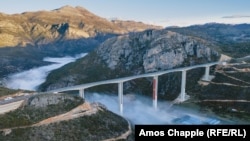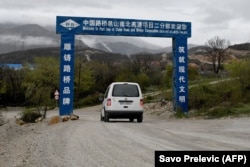PODGORICA -- In a show of confidence in its finances, Montenegro will end a deal with Western banks that protected it from increased debt on a controversial Chinese loan for nearly $1 billion used to build a highway.
The move is the latest chapter in the saga of Montenegro's controversial Bar to Boljare highway -- which was built by the China Road and Bridge Corporation (CRBC) and financed by the Export-Import Bank of China with the immense loan -- and created long-term economic risk by saddling the country with debts to Beijing that once totaled more than a third of the state budget.
The Montenegrin Finance Ministry said in a statement that it was leaving the agreement due to "favorable market conditions."
In exiting the deal that converted its dollar debt to the Chinese bank into euros, the ministry said on June 14 that it "earned approximately $64 million" after reverting to the recently strengthened dollar. It said it will use that money to help make its next debt payment to China in January.
Finance Minister Aleksandar Damjanovic told Radio Montenegro after the announcement that due to mounting uncertainty in global markets, it was too risky to remain in the deal.
"During the hedging arrangement, we got the external instability of the financial markets [and] the war in Ukraine, which has consequences for Europe, [like] an unstable currency relationship with the world," said Damjanovic.
The highway venture has grappled with construction delays, growing costs, environmental concerns, and criticism over cursory Chinese lending practices and local corruption.
Under the original plan inked in 2014, the initial 41 kilometers -- which opened in July 2022 -- was to be part of a 163-kilometer highway connecting Montenegro's Adriatic coast with neighboring Serbia. The project aimed to transform the country into a transport hub for the wider region and bolster economic activity, but the highway still faces lingering questions about whether the remaining 122 kilometers of road will be completed.
The highway made global headlines in April 2021 when Montenegrin officials asked the European Union for help to repay the large loan when its first installment was due that summer. As Brussels weighed its response, European advocates for financial help within the bloc warned that the country of 620,000 people was at risk of a financial takeover by China.
The result was a July 2021 deal brokered between Montenegro -- with the help of the EU -- and four Western financial institutions: Goldman Sachs, Merrill Lynch, Societe Generale, and Deutsche Bank.
The 14-year arrangement, which included an opt-out clause after two years, was designed to protect from volatility in the euro-dollar exchange rate, which directly affected the amount of the debt.
Because Montenegro, which uses the euro, didn't hedge against currency swings and failed to include a turnpike in its original plans, the price of the project continued to rise. As the value of the dollar rose against the euro, the cost of the highway increased at one point by more than $100 million.
Why Is Montenegro Leaving The Deal?
The hedging deal was reached before the first debt payment was due, so Podgorica has made its first four installments worth $158 million in euros with a lower interest rate, according to the Finance Ministry.
The arrangement meant Montenegro would pay in euros at an interest rate of 0.88 percent, instead of in dollars with an interest rate of 2 percent, as originally agreed in 2014 when the project was first announced. That means Podgorica has paid the Export-Import Bank of China $25 million (23 million euros) less than if the loan remained tied to the dollar exchange rate.
While the Montenegrin government has justified its decision as necessary given gloomy market forecasts for the eurozone, which entered a recession in the first quarter of this year, not all inside the country have accepted the official explanation.
Milojko Spajic, who was finance minister when the hedging deal was reached, believes the government opted out of the arrangement because its state coffers are running low and needed the $64 million that it earned from exiting the deal to meet its upcoming debt payment.
"The real reason for this government's exit from [the] hedging [deal] is that there is no money in the treasury," he said during a June 16 appearance on Radio and Television of Montenegro.
It is difficult to verify Spajic's claim, but an analysis by RFE/RL's Balkan Service of the Finance Ministry's budget over the past four months showed higher-than-planned revenues in relation to flat expenditures. The summer season, with an expected new high in tourism for the country, could further add to that extra income.
Mirza Muleskovic, an economic analyst and the founder of the Podgorica-based consultancy Inteligencija MNE, said it is difficult to say how leaving the hedging agreement will play out for Montenegro, adding that it will be contingent on hard to predict changes in the market due to global events.
"No one can predict what will happen on a global level, especially in regards to currency risk," he told RFE/RL. "One event can disrupt everything."
What's Next For the Highway?
The future of the remaining two sections of the highway is uncertain, but fallout from the project is still coming down across the country.
Montenegro's Capital Investment Ministry told RFE/RL in April it has initiated proceedings as laid out in its contract with CRBC for penalties due to years of delays past the original deadline for the first 41-kilometer stretch of highway. The ministry did not say how much it sought to collect from the Chinese company or a timeline for the procedure.
The project has also faced sustained scrutiny from the Network for the Affirmation of the Nongovernmental Sector, a Balkan watchdog organization. The group raised corruption and transparency concerns over how construction contracts were distributed to Chinese and local companies, and also brought criminal charges against CRBC over environmental damage to the bed of the Tara River. Those charges, however, have since been dismissed.
Despite the political turmoil brought by the highway, Chinese companies and lenders still have a foothold in Montenegro.
In March, Podgorica again turned to a Chinese consortium and awarded contracts to build a $59 million highway that will improve the main connection between the coastal towns of Budva and Tivat.











